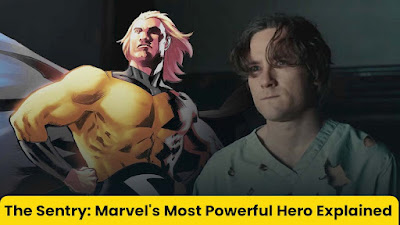The Sentry: Origin Story, Powers, and Influence in the Marvel Universe
The Sentry, also known as Robert Reynolds, stands as one of Marvel’s most complex and powerful characters. Created by Paul Jenkins and Jae Lee, he debuted in Sentry (2000) #1 as a forgotten hero with a dark secret12. His story intertwines god-like abilities, psychological struggles, and a legacy that reshaped the Marvel Universe. Below, we explore his origin, powers, key story arcs, and why he remains a compelling figure despite his flaws.
The Origin of The Sentry: A Hero Emerges from Desperation
The Origin of Project: Sentry
The Sentry's origin starts with Project: Sentry, a covert government project to create an enhanced version of the Super-Soldier Serum that produced Captain America1. Decades following World War II, scientists attempted to enhance the effects of the serum, hoping to create a soldier with unparalleled physical and mental abilities. The project was shelved because of ethical issues and the unstable nature of the formula.
Robert Reynolds' Transformation
Robert Reynolds, a stricken youth with addiction problems, found the lab where the Golden Sentry Serum1 was kept. Desperate for a fix, he drank the serum, which changed his molecular configuration and gave him superhuman powers. This made him the Sentry—a superhero as strong as the Hulk, faster than light, and with powers of warping reality.
The Void: The Dark Counterpart
With great power came a devastating cost. The Sentry’s existence birthed the Void, a monstrous entity representing his darkest impulses. The Void’s origins remain ambiguous—some theories suggest it is a cosmic force, while others link it to a psychic virus created by Mastermind. Regardless, the Void became Sentry’s greatest enemy, forcing him to erase his own memory and legacy to contain the threat.
The Sentry’s Powers: A Universe-Level Threat
Physical and Mental Enhancements
Golden Sentry Serum provided Reynolds superhuman strength, speed, stamina, and resilience2. He can lift helicarriers whole, outrun bullets, and withstand planetary detonations. His senses are just as augmented—he can hear a butterfly's heartbeat from across continents and perceive microscopic or telescopic details with ease.
Molecular Manipulation and Energy Projection
The Sentry's most terrifying power is molecule manipulation, where he can break down matter at his whim. He once took apart Carnage with ease and drew with Galactus. He also fires energy blasts that can hurt World-Breaker Hulk and burn Celestials2 to ashes.
Resurrection and Immortality
Reynolds is invincible to death. When he was killed by Thor during Siege (2010), his corpse returned to life in the Sun, stuck in an eternal loop of death and resurrection. The Void deserted him, returning the Sentry to reclaim his title as Earth's defender.
Psychological Weaknesses
In spite of his authority, the Sentry's instability constrains him. His schizophrenia and addiction issues make him vulnerable to manipulation, as when Norman Osborn manipulated him in Dark Avengers12. The Void's presence tends to dominate his heroism, and there is a tragic duality.
Major Story Arcs: The Sentry's Legacy
Civil War and the Mighty Avengers
During Civil War, Sentry first tried to stay away from conflict but later joined Iron Man's Pro-Registration movement. Later, he was a pillar of the Mighty Avengers, fighting Ultron and Doctor Doom2. His lack of control over powers, however, resulted in collateral damage and poor relations with team members.
World War Hulk: Clash of Titans
During World War Hulk, the Sentry fought an infuriated Hulk angry at the Illuminati and hungry for revenge. Their fight wrecked Manhattan buildings, culminating in a standstill that both heroes were weakened and drained. This arc emphasized the Sentry's brute power and his fear of unleashing it to the fullest.
Siege: The Void's Apotheosis
Norman Osborn manipulated the Sentry to join the Dark Avengers, giving him more serum to activate the Void1. During Siege, the Void killed Ares and destroyed Asgard, compelling Thor to have to kill Reynolds. This was a tragedy that highlighted the Sentry's failure to overcome his inner darkness.
Resurrection and Redemption
Revived as an Apocalypse Horseman, the Sentry atoned by saving Earth from cosmic danger. His last act was to carry a Celestial's body into outer space, showing his dedication to humanity in spite of his dark past.
Honest Review: The Sentry's Strengths and Weaknesses
Strengths
- Unequaled Power: The Sentry's powers render him a deus ex machina in times of crisis, able to beat foes no other hero can.
- Psychological Depth: His addiction and mental illness make him more of a complex figure than most heroes.
- Moral Complexity: The Void's presence makes it difficult to ask if total power can ever actually be heroic.
Weaknesses
- Inconsistent Writing: Certain arcs (Dark Avengers) abuse the use of the Sentry as a narrative device instead of delving deeper into his psyche.
- Overpowered Nature: His near-omnipotence diminishes dramatic tension, for few threats realistically challenge him.
- Underutilized Potential: His stories tend to concentrate on his fall instead of his heroism, squandering potential for development.
Recommendations: Must-Read Sentry Stories
- Sentry (2000) #1: The origin story that introduces Reynolds and the Void.
- World War Hulk (2007): Includes his epic battle with the Hulk.
- Siege (2010): Details his tragic fall and death.
- Uncanny Avengers (2015): Sees his resurrection and redemption.
Conclusion: A Flawed Guardian
The Sentry represents the paradox of power—unrivaled strength combined with extreme vulnerability. Though his tales periodically stumble under the burden of his powers, his psychological depth guarantees lasting significance. For readers looking for a hero beyond good-vs-evil models, the Sentry provides an engaging, albeit flawed, journey.
Final Verdict: The Sentry is an interesting character that's best enjoyed in small quantities. Begin with his early comics to understand his promise, then investigate darker storylines for a realistic picture of the price of power.

